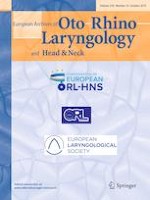01-10-2019 | Otoscopy | Short Communication
Utility of a smartphone-enabled otoscope in the instruction of otoscopy and middle ear anatomy
Published in: European Archives of Oto-Rhino-Laryngology | Issue 10/2019
Login to get accessAbstract
Purpose
To present the utility of a smartphone-enabled otoscope as a teaching adjunct in pre-clinical otoscopy training.
Methods
60 pre-clinical medical students were randomized into either a control group using a conventional otoscope or an experimental group using a smartphone-enabled otoscope. Participants in each group were trained to use their assigned device and were given time to practice on a colleague’s ear. Participants then completed a questionnaire indicating their ability to visualize anatomical landmarks of the middle ear as well as their confidence in performing a middle ear examination using their device.
Results
Compared to participants using the conventional otoscope, significantly more students using the smartphone-enabled otoscope identified the umbo (93% versus 63%, P = 0.005), the short process of the malleus (67% versus 33%, P = 0.008), the cone of light (100% versus 70%, P = 0.001), and the pars flaccida (60% versus 33%, P = 0.03). Furthermore, participants who used the smartphone-enabled otoscope reported significantly increased confidence in performing otoscopy compared to those who used a conventional otoscope (4.1 ± 0.7 versus 2.8 ± 0.9, P < 0.001). Finally, participants rated the smartphone-enabled otoscope as an excellent teaching aid for otoscopy training.
Conclusion
The smartphone-enabled otoscope serves as a valuable teaching tool for pre-clinical otoscopy education. After using the device, pre-clinical students were more confident in performing a middle ear examination and in identifying important anatomical landmarks of the middle ear.





